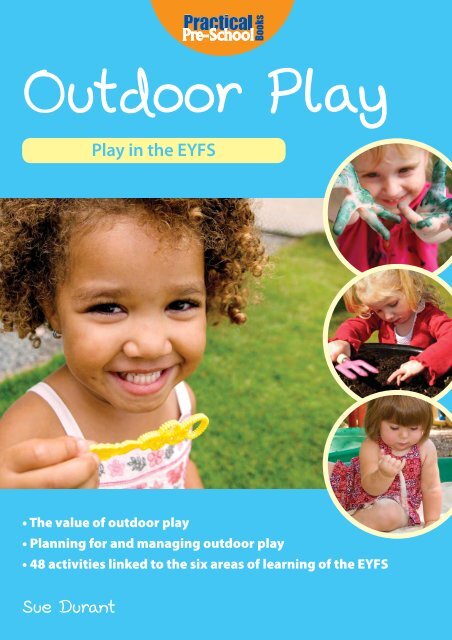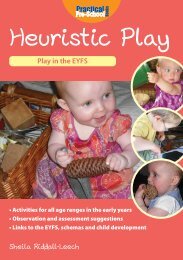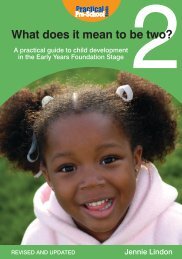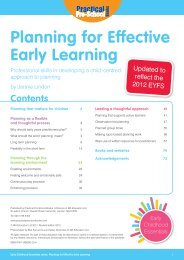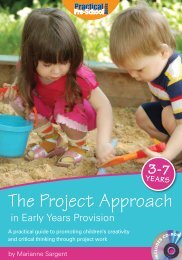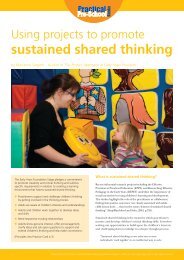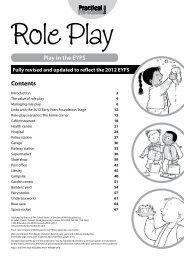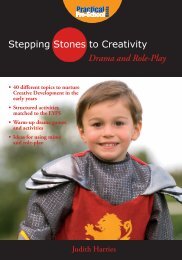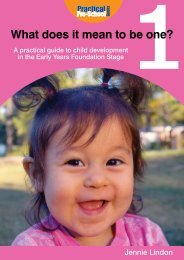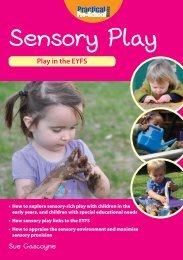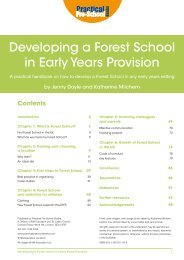Sue Durant - Practical Pre-School Books
Sue Durant - Practical Pre-School Books
Sue Durant - Practical Pre-School Books
- No tags were found...
Create successful ePaper yourself
Turn your PDF publications into a flip-book with our unique Google optimized e-Paper software.
<strong>Books</strong><br />
Outdoor Play<br />
Play in the EYFS<br />
• The value of outdoor play<br />
• Planning for and managing outdoor play<br />
• 48 activities linked to the six areas of learning of the EYFS<br />
<strong>Sue</strong> <strong>Durant</strong>
<strong>Books</strong><br />
Outdoor Play<br />
Play in the EYFS<br />
Contents<br />
The value of outdoor play 2<br />
Best practice 5<br />
Planning for outdoor play 7<br />
Managing outdoor play 15<br />
Resources to support<br />
outdoor play 21<br />
Activities to support<br />
outdoor play:<br />
Personal, Social and<br />
Emotional Development<br />
Soapy sand 28<br />
Outdoor art gallery 28<br />
What am I 29<br />
Dressing-up game 30<br />
Runaround rabbit 30<br />
Stations 31<br />
Change seats 32<br />
Water chain 32<br />
Blindfold walk 33<br />
Wheelchair play 33<br />
Communication,<br />
Language and Literacy<br />
We’re going on a bear hunt 34<br />
The letter hunt 34<br />
Writing in mud/sand 35<br />
Dig for letters 36<br />
Magic carpet journey 36<br />
Message in a bottle 37<br />
Letters 37<br />
In the pond 38<br />
Letter from a lost teddy 38<br />
Kim’s game<br />
(with a difference!) 39<br />
Problem Solving,<br />
Reasoning and Numeracy<br />
Rope walk 40<br />
Stepping stones 41<br />
The old woman who<br />
lived in a shoe 42<br />
The hungry caterpillar 42<br />
The circle game 42<br />
Published by <strong>Practical</strong> <strong>Pre</strong>-<strong>School</strong> <strong>Books</strong> , A Division of MA Education Ltd,<br />
St Jude’s Church, Dulwich Road, Herne Hill, London, SE24 0PB Tel 020 7738 5454<br />
© MA Education Ltd 2009<br />
www.practicalpreschoolbooks.com<br />
Front cover main image © iStockphoto.com/Nicole S. Young<br />
Front cover images from top to bottom © iStockphoto.com/Rebecca Grabill, © iStockphoto.com/Gary Sludden,<br />
© iStockphoto.com/Meredith Mullins<br />
All rights reserved. No part of this publication may be reproduced, stored in a retrieval system, or transmitted<br />
by any means, electronic, mechanical, photocopied or otherwise, without the prior permission of the publisher.<br />
Play in the EYFS: Outdoor Play ISBN: 978-1-90457-598-6
The value of outdoor play<br />
Not all children attend well-equipped nurseries with<br />
exciting and challenging outdoor areas. Some go to village<br />
halls or community centres with little or no access to an<br />
outside area, some go to nurseries attached to schools<br />
and some children play in someone’s front room! But<br />
all early years settings should be providing outside play<br />
opportunities regardless of their facilities.<br />
All groups of children are different but in every group<br />
there will be some children who learn best when they are<br />
outside. To make it easier for these children to learn, you<br />
need an environment that is safe, inviting, stimulating and<br />
challenging. No matter how small the space, it can be made<br />
interesting, even if the equipment has to be set up and<br />
stored away each day. Those settings that have no outdoor<br />
space available to them could think about investigating the<br />
local park, woodland area and immediate surrounding area.<br />
Ideally, the children should be able to move from the<br />
indoor to the outdoor areas with minimum fuss, but this<br />
is not always possible. Some settings have areas available<br />
to them but they are not attached to their indoor space.<br />
Careful planning is the answer. It may be that groups of<br />
children go to the area at one time. This is not ideal and<br />
care must be taken that all of the children are given equal<br />
access; this means those that want to go outside can rather<br />
than ‘It’s your turn now so you must go’.<br />
In many settings children go outside only when the<br />
weather is warm and sunny. This is often not the children’s<br />
choice but the adults! Children don’t notice the weather<br />
and will choose to go outside even when it is cold and<br />
rainy. If they are equipped with wellies and macs they<br />
should be outside. How else will they have the experience<br />
of just being in the rain Smelling it Seeing puddles<br />
form and jumping in them Watching the stream of water<br />
coming from the downpipe Wondering where all the<br />
water goes<br />
Outdoor play is as important as indoor play. Space, fresh<br />
air, freedom and time are essential for children’s emotional,<br />
social and personal well-being.<br />
Outdoor play is vital because:<br />
• It enables children to become independent learners.<br />
Children should enjoy learning and you can help them<br />
to develop that all-important disposition to learn by<br />
providing them with an environment which they can<br />
explore, modify and use themselves. If they need to<br />
keep asking you for equipment or resources you are<br />
taking away their independence.<br />
You can invite the children to make choices, follow<br />
their own interests and get involved with what they are<br />
doing. For some children the outdoors is where they<br />
are most comfortable.<br />
• It encourages social and moral development.<br />
Outdoor play presents opportunities for exploring and<br />
using large equipment. This involves children in taking<br />
turns, sharing, cooperating, negotiating and talking<br />
to each other - all essential skills when interacting<br />
with other people in a positive way. They will establish<br />
relationships and begin to understand that others<br />
have feelings and emotions, for example seeing friends<br />
become upset when hurt, and being able to empathise.<br />
• It encourages children to grow in confidence and selfesteem.<br />
Some children appear more comfortable with<br />
themselves and others when they are outside. They<br />
play with confidence in the knowledge that they can<br />
be noisier and more boisterous and they do not feel as<br />
restricted as they may do indoors.<br />
Confidence and self-esteem are crucial for children’s wellbeing<br />
and ability to learn. Those children who are given<br />
opportunities to achieve success, whether it is through<br />
being able to be good at climbing or being leader in an<br />
imaginative game, are the most likely to enjoy satisfaction<br />
and a feeling of well-being. They will want more.<br />
• It promotes and enables physical activity.<br />
Joining in physical activity can have huge benefits for<br />
Outdoor Play 3
• It allows time to consolidate skills learned.<br />
Children need time to repeat, mimic, and try once more<br />
the skills they have been learning. Sometimes this may<br />
be through giving them the time alone. At other times<br />
it may be through providing for the same skills with a<br />
wider range of activities and experiences that may be<br />
bigger, noisier, messier than those offered indoors.<br />
young children. It can help them to cope with success<br />
and failure in a supported environment and to develop<br />
a sense of fair play.<br />
It makes a unique contribution to the development<br />
of the whole child and research evidence suggests<br />
there is a link between physical activity and academic<br />
achievement, as well as an improvement in children’s<br />
behaviour and the development of social interaction<br />
(Using Physical Activity and Sport DfES 2000).<br />
Giving children the choice to be outside is a powerful<br />
tool. Conflicts can be resolved more easily and<br />
imaginative, well planned, challenging areas for<br />
children with diagnosed behavioural problems can<br />
often result in calmer, more interested children.<br />
We all know young children need space, as movement is<br />
central to their development and learning. Their motor<br />
development is at a crucial stage and they need to be<br />
given opportunities to strengthen their large muscles to<br />
improve the control of their smaller ones. (To write with<br />
control they will need to develop their arm and shoulder<br />
muscles as well as their hand and finger muscles.)<br />
• It allows children to take risks.<br />
Children’s safety is of paramount importance and you<br />
need to be mindful when planning the outside area<br />
but too many restrictions can reduce choice and make<br />
children dependent on adults. Children will take risks in<br />
their play that they are comfortable with because they<br />
set their own agenda.<br />
Good practice<br />
Whatever facilities you have available, good practice in<br />
outdoor play means that the children are in the most<br />
effective teaching and learning situation. They will be<br />
given challenges that are both exciting and stimulating<br />
so that they want to find out more. The adults will be<br />
supporting and intervening at appropriate times because<br />
they have observed the children and know at what stage<br />
to intervene in order to carry them forward. (Sometimes<br />
the children are best left to do this for themselves.)<br />
Good practice means:<br />
• that, if possible, the children can go outside whenever<br />
they need to;<br />
• planning what the children will experience so that their<br />
learning is seamless and interlinked and enables them<br />
to join up their thinking;<br />
• the area is so organised that the children understand<br />
the systems, for example where to get equipment if<br />
they want it, what to do if they need help;<br />
• that the children themselves can change and modify<br />
the area to suit their methods of play at that time;<br />
• having an area that is versatile so that the children can<br />
look forward every day to something that is stimulating<br />
for them. Sometimes if children are working on a<br />
project they do not want to put it away at the end of<br />
the day or session. Being versatile means being able to<br />
accommodate their needs and leaving it so the children<br />
can go back to refine it until it has run its course;<br />
• having committed staff and helpers who understand<br />
the value of children playing outside.<br />
<br />
Outdoor Play
Activities to support<br />
Communication Language and Literacy<br />
We’re going on a bear hunt<br />
What you want the children to learn or develop<br />
To interact with others and take account of what they say<br />
Linked areas of learning<br />
Problem Solving, Reasoning and Numeracy<br />
Physical Development<br />
Personal, Social and Emotional Development<br />
Themed links<br />
Teddy bears, Animals, Journeys, Story – We’re Going on a<br />
Bear Hunt<br />
Resources<br />
We’re Going on a Bear Hunt (Walker <strong>Books</strong>)<br />
Teddy bear<br />
Large cardboard box<br />
Blanket<br />
Strip of corrugated card<br />
Soft, blue material (for river)<br />
Art straws/long grasses<br />
Read the story. Tell the children that they can re-enact the<br />
story outside using any of the equipment.<br />
Provide a wide variety of resources but be prepared to<br />
respond if the children have other ideas for what they’d<br />
like to use. They may well use the equipment given but in a<br />
different way to that which you had planned.<br />
Stand at a discrete distance and watch how they interact with<br />
each other. Be prepared to intervene sensitively if necessary.<br />
• Encourage positional language when appropriate, for<br />
example going through a tunnel, over a bench, under<br />
a blanket. They can make a cave and hide the teddy<br />
inside.<br />
• Encourage them to perform to friends/parents/the rest<br />
of the class.<br />
• Suggest they make up an alternative ending, use<br />
another animal or have different obstacles.<br />
If there is a piece of woodland or some trees nearby,<br />
some laminated signs or arrows and a bear cave can be so<br />
exciting! Signs could say:<br />
‘This way to the bear cave’,<br />
‘Sssh! Bears asleep!’,<br />
‘Please keep to the path’,<br />
‘Danger!’,<br />
‘To the woods’.<br />
Letter hunt<br />
What you want the children to learn or develop<br />
To be able to recognise the letters in their own name<br />
Linked areas of learning<br />
Physical Development<br />
Personal, Social and Emotional Development<br />
Themed links<br />
Explorers, Ourselves<br />
Resources<br />
Large, laminated name cards<br />
Large, single alphabet letters<br />
Large timer<br />
Put the letters all around the outdoor area so that they can<br />
be easily seen. Hang them over a wooden fence, on hooks<br />
along a wall or scatter them on the grass.<br />
The children you want to target should each have their<br />
name card and can run around looking for their letters in<br />
the order in which they appear on their cards. They will<br />
collect them up and could perhaps place them under or<br />
over their name cards. As they get used to the game, they<br />
34<br />
Outdoor Play
can leave their cards in a central place and find their letters<br />
by remembering the letter shape they want next.<br />
Give the children time to do this, helping them at first.<br />
Some children especially like playing the game against a<br />
timer. How quickly can they find their letters Has the timer<br />
run out<br />
Extension ideas<br />
• The game can be extended to include looking for<br />
significant words – perhaps linked to the theme.<br />
• Older children enjoy finding words and rearranging<br />
them into a sentence that may relate to a story/theme.<br />
Writing in mud/sand<br />
What you want the children to learn or develop<br />
To use writing as a means of recording and communicating<br />
Linked areas of learning<br />
Knowledge and Understanding of the World<br />
Problem Solving, Reasoning and Numeracy<br />
Themed links<br />
Shapes, Materials, Earth, Counting, Transport<br />
Resources<br />
Large shallow tray<br />
Damp earth/mud/sand<br />
Variety of writing implements, for example sticks,<br />
twigs, feathers<br />
An activity for the child to record<br />
This activity is used widely as an open-ended play activity<br />
but it can also be used in a more focused way. <strong>Pre</strong>pare a<br />
large tray – builders’ trays are wonderful for this – and fill<br />
it with wet sand/mud. Provide a wide variety of writing<br />
implements such as twigs and feathers of different<br />
thicknesses and sizes.<br />
Decide which child will be the writer and agree on an<br />
activity. This can be how many times a child can complete<br />
a course on their bike without knocking something over,<br />
or how many times they can throw a bean bag into a box<br />
– simple activities that can easily be counted.<br />
Outdoor Play 35


